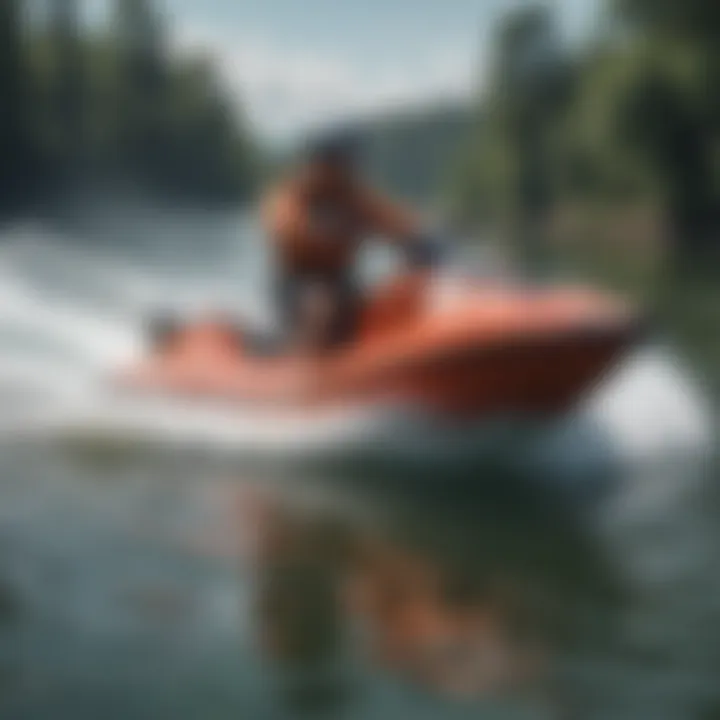Motorized Fins: Transforming Watersports and Safety


Intro
The world of watersports has seen a dramatic transformation in recent years, largely due to advances in technology. One fascinating innovation has been the advent of motorized fins, an enhancement that has not only amplified performance but has also changed the way enthusiasts engage with water activities. These fins serve as a bridge between tradition and innovation, combining the thrill of aquatic sports with cutting-edge engineering.
As watersports enthusiasts—whether surfers, paddleboarders, or kitesurfers—seek to harness the power of the water in new and exciting ways, understanding the evolution and impact of motorized fins becomes essential. This article aims to dissect the journey of motorized fins, shedding light on their technical development, functionalities, and impacts on safety and performance across diverse aquatic sports.
The conversation goes beyond mere technical specifications. It raises important questions: How do motorized fins enhance user experience? What are the implications for safety on the water? Additionally, as these technologies bloom, one must consider their environmental implications and forthcoming trends in watersport innovation.
By the end of this exploration, readers will be equipped with knowledge that not only contextualizes the relationship between technology and recreation but also plans their adventures on the water more effectively. Now, let’s delve into the vital gear essentials that accompany the world of motorized fins.
Preface to Motorized Fins
Motorized fins have made quite a splash in the watersport world. They represent a significant leap in both technology and the way enthusiasts engage with aquatic activities. These devices merge traditional paddling or finning techniques with motorized precision, paving the way for enhanced performance and entirely new experiences on the water. Their growing popularity among surfers, paddleboarders, kitesurfers, and instructors speaks volumes about their effectiveness and the excitement they bring to the scene.
Definition and Purpose
Motorized fins are specialized devices that attach to the feet or boards of watersport enthusiasts, providing propulsion through water without the need for vigorous paddling or legwork. Unlike traditional fins, these advanced tools are equipped with small, efficient motors that spin to create thrust, allowing users to glide across the surface with minimal effort. The primary purpose of these fins is to enhance speed and mobility while reducing fatigue. This innovation not only benefits the seasoned surfer looking to catch that perfect wave but also assists newcomers who may still be grappling with balance and technique.
Historical Context
The evolution of motorized fins didn’t happen overnight. The concept has its roots in early watercraft and the desire for increased efficiency on water. Pioneering designs can be traced back to the mid-20th century when researchers began experimenting with motorized propulsion systems for various marine vehicles. However, it wasn't until the late 1980s and early 1990s that the technology found its footing in recreational watersports.
Initially, the application of motorized technology was limited to larger vessels. But as advancements in battery technology and materials science emerged, developers began shrinking these systems, making them feasible for personal watersport gear. Companies started to introduce motorized fins and devices aimed at enhancing experiences for users, showing that innovation often rides on the coattails of necessity and imagination.
"Motorized fins have changed the game, making it easier for everyone to enjoy what the water has to offer."
From the windswept shores of Hawaii where surfers began to experiment, to tranquil lakes where paddleboarders embraced the freedom of movement, the historical journey of motorized fins is a testament to human ingenuity and the constant quest for improvement. The integration of these motorized devices has since opened avenues of creativity and new styles of play on the water, ultimately redefining the very essence of watersports itself.
Technological Advancements in Motorized Fins
The landscape of watersports is undergoing a significant transformation largely due to the breakthroughs in motorized fin technology. These advancements encompass a range of elements, from sleek design innovations to sustainable power sources. With the rapid progress in this area, manufacturers are rethinking how fins can enhance performance and reshape the experiences of surfers, paddleboarders, kitesurfers, and their instructors. This section aims to dissect these developments and illustrate the myriad benefits they bring to the watersport community.
Design Innovations
The design of motorized fins has evolved remarkably over recent years. Early prototypes were often bulky and awkward, but today’s models are designed to integrate seamlessly with the fluid nature of water sports.
Modern fins often feature contour designs that reduce drag, optimizing the interaction with the water. These innovations allow users to slice through waves with greater ease and speed. For example, some fins come with adjustable settings that can change their angle, allowing for more tailored performance based on the specific conditions of the day. This adaptability not only caters to different skill levels but also enhances maneuverability in challenging situations.
Moreover, the aesthetics of motorized fins have improved markedly. Sleek lines and vibrant colors not only make these fins visually appealing but can also reduce resistance at higher speeds. This perfect marriage of functionality and style is driven by consumer demand for both high performance and eye-catching gear. These advancements signify a shift from utilitarian designs to more sophisticated, multi-functional sports equipment.
Materials Used
The choice of materials for motorized fins plays a pivotal role in their effectiveness. Traditionally, fins were made from a variety of rigid materials that lacked flexibility. However, new manufacturing processes are paving the way for the use of advanced composites, such as carbon fiber and reinforced plastics.
These modern materials are lighter, yet sturdier, providing an optimal balance between weight and durability. For instance, carbon fiber fins allow for high-speed rides while maintaining structural integrity, which is crucial during turbulent waters. Additionally, the use of environmentally-friendly materials reflects a growing awareness of sustainable practices within the industry.
Furthermore, innovations in waterproofing technologies have helped create fins that are more resistant to wear and tear. This extends their lifespan and reduces the frequency of replacements, thus reducing environmental impact in the long run.
Power Sources and Efficiency
Power sources have undergone their own revolution, moving away from traditional methods to more efficient and sustainable options. The introduction of battery technologies that support high energy outputhas changed the game. Many modern motorized fins now utilize lightweight lithium-ion batteries, which not only maximize power output but also minimize weight—an important consideration for any water sport.
Efficiency is key here. Recent advancements have focused on optimizing energy consumption, allowing users to cover more distance without frequent recharges. Some innovations include solar charging options, which align well with the eco-friendly values of the watersport community. With these changes, enthusiasts can revel in extended sessions without the hassle of packing extra batteries or scouting for charging spots.
The combination of solid design choices, innovative materials, and efficient power systems is redefining the way motorized fins are perceived and utilized. As these technologies continue to evolve, they present exciting possibilities for the future of watersports, broadening access for novice users while still catering to the seasoned professionals seeking that edge in performance.


Functionalities and Applications
The significance of functionalities and applications in the realm of motorized fins cannot be understated. These advanced pieces of equipment fundamentally change the way enthusiasts interact with the water, bringing forth both practicality and increased thrill. The fusion of engineering with aquatic sports creates a new dimension for recreational and competitive activities alike. By enhancing user experience through speed, maneuverability, and adaptability, motorized fins allow for broader participation and personalization in watersport activities. Let’s examine these aspects one by one, and appreciate their impact on the landscape of watersports.
Enhancing Speed and Maneuverability
Motorized fins serve as a game-changer when it comes to speed. Traditional paddling can be grueling, and for those hoping to cover distance efficiently, the water often becomes a battlefield of stamina. However, when equipped with motorized fins, users can glide through with added propulsion that enables them to zip across the surface with minimal effort. This increase in speed is not just about going fast; it translates into more fun and an opportunity to explore further reaches of waterways that may have seemed inaccessible or tiring before.
Moreover, the enhanced maneuverability that these fins provide plays an essential role in various watersports. Picture yourself trying to navigate through tight spaces, be it amidst waves or coral reefs. Motorized fins grant the rider a remarkable ability to sharply turn and easily adjust course. This is particularly beneficial for activities like kitesurfing and surfing, where agility can determine whether you catch the next wave or wipe out.
Customizable Settings
Personalization stands at the forefront of modern-day technology in all sectors, and watersports are no different. Motorized fins come equipped with customizable settings that cater to individual preferences and skill levels. Whether you're a seasoned paddleboarder looking to harness planning characteristics, or a newbie just wanting a smooth glide, these fins can be adjusted accordingly.
Options often include speed settings allowing users to dial in their desired velocity. The ability to modify thrust power can create a comfortable balance that matches unique user abilities and styles of play. This means less strain on the body and more enjoyment on the water, as riders can fine-tune their experiences to best suit their needs.
Integration with Existing Watersport Gear
One of the most exciting aspects of motorized fins is their capacity to seamlessly integrate with existing watersport gear. Gear diversity is a hallmark of the watersports community. Surfers, paddleboarders, and kitesurfers often invest in an array of equipment that suits their personal style or preferred activity. The good news is that motorized fins are designed to be compatible with various types of board configurations.
This adaptability means that enthusiasts don’t need to overhaul their entire kit to experience these benefits. Instead, they can attach a fin to their existing boards and enjoy an enhanced experience. This feature lends itself to a more economical approach, easing the financial burden associated with staying current in a rapidly evolving field.
Impact on Watersport Dynamics
The rise of motorized fins has altered the landscape of watersports in significant ways. This section ventures into understanding how these innovations affect various aspects of aquatic recreation, including skills, safety, and competition. The infusion of technology into these sports is reshaping dynamics that have remained largely unchanged for decades, drawing attention from enthusiasts and professionals alike.
Changing Skill Requirements
Motorized fins have introduced a shift in the skill sets needed for participating in watersports. Before the advent of these devices, activities like surfing or paddleboarding required a high level of stamina, balance, and technique. Users would spend long hours honing their abilities through rigorous training and practice. Now, with the assistance of motorized fins, individuals can experience increased speed and ease in maneuverability, which can somewhat diminish the traditional demand for pure skill.
There’s a dual-edge here. On one hand, newcomers can hop onto the water and feel a taste of speed and freedom without extensive training. On the other, seasoned athletes might feel a wrench in the fabric of their sports. Competitions might find themselves asking, "How do we measure skill now?" This leads to a growing debate about recalibrating performance metrics to weigh the enhancement provided by technological advancements.
Safety Enhancements
In the realm of safety, motorized fins provide a notable boost. Traditional watersports often pose risks related to fatigue, especially when paddling or surfing significant distances. With the implementation of motorized fins, enthusiasts can cover more ground while exerting less physical energy, which translates to lower chances of exhausting oneself. This is a substantial advantage, particularly in environments prone to sudden weather changes or currents.
Moreover, many motorized fins are designed with user safety in mind. Features include automatic shut-off systems that activate in case of a fall or a water entry at high speeds. This could dramatically reduce the likelihood of accidents. For example, imagine a kitesurfer who loses balance: a well-designed motorized fin could safely bring them back to the shore, thereby enhancing their overall experience and confidence on the water.
"Technology in watersports is a game-changer. It not only elevates performance but also prioritizes the safety of participants."
Influence on Competitive Events
The integration of motorized fins into competitive events opens up a Pandora’s box of possibilities. Realistically, competitions may need to adjust their formats or rules to account for these new tools. Speeds can be amplified, and courses can be adjusted to welcome a wider range of skill levels.
However, there's the lingering question of fairness and equity in competition. If one participant is equipped with a high-end motorized fin while another uses a traditional setup, does that create an uneven playing field? Organizations have started exploring regulations regarding the use of motorized fins in official settings, and discussions are ongoing to formalize how to level the competition while integrating innovation.
Occupying this intersection of tradition and technology presents both challenges and opportunities, pointing to an evolving future for competitive watersports. As athletes embrace these advancements, the landscape of competition awaits a renaissance, balancing modernity with the spirit of sport.
Environmental Considerations
Understanding the environmental considerations surrounding motorized fins in watersports is essential, not only for enthusiasts and practitioners of the sport but also for the health of the marine environments we cherish. As water sports become increasingly popular and technologically advanced, it's crucial to ponder our impact on oceanic and freshwater ecosystems. The significance of this topic goes beyond company logos or product launches; it's about ensuring our aquatic hobbies do not come at the expense of nature.
Energy Consumption and Sustainability
The issue of energy consumption is one that cannot be brushed aside. Motorized fins often require significant power to function, prompting questions about their sustainability. The question that pops into the minds of many surfers or paddleboarders is: Are these fins contributing to a greener future or steering us down a murky path?


One of the key factors to look at is the shift towards more energy-efficient designs and power sources. Manufacturers are gradually recognizing the need for sustainability. Some models have embraced lithium-ion batteries for their lightweight properties and impressive energy density. This allows for extended use without the weight burden that leads to fatigue during long sessions. In addition, solar charging options are emerging, providing a glimpse into a future where the sun might power our passion for watersports.
In terms of practical benefits, using more efficient fins can lead to lower energy demands, reducing the reliance on fossil fuels. However, it's also critical to understand the life cycle of these products. Are they recyclable? Do they comprise materials that are feasible for disposal? Answers to these questions can help guide consumers toward making environmentally responsible choices.
Impact on Marine Ecosystems
Motorized fins can potentially shake up the delicate balance of marine ecosystems. Understanding this impact is crucial, especially with the increasing number of aquatic sports enthusiasts hitting the water.
When boats or personal watercraft are buzzing about, the sound and disturbance can affect the behaviors of marine wildlife. Fish, for instance, might migrate away from heavily trafficked areas, leading to long-term changes in local biodiversity. Similarly, noise pollution can interfere with communication among marine mammals. It's no secret that these creatures rely on sound for locating prey and social interaction.
Moreover, the proliferation of motorized gear raises concerns about habitat degradation. Many watersport enthusiasts may unknowingly ride over sensitive areas like coral reefs, which take years to regenerate.
Fins that are designed with eco-friendliness in mind could help mitigate these impacts. For example, lightweight models that assist in efficiently navigating the desired water levels could encourage less disturbance. Enhanced designs which minimize wake can preserve the integrity of surf zones and aquatic habitats.
"Balancing technology and nature in watersports is not just a necessity, it is our responsibility as stewards of aquatic environments."
Future Trends in Motorized Fin Development
As innovation continues to flow through the world of watersports, understanding future trends in motorized fin development becomes crucial. The importance of this is multi-faceted and touches on various elements such as technological advancements, changing consumer preferences, and the overall evolution of water sports equipment. Keeping a finger on the pulse of these trends not only informs enthusiasts and professionals but also helps in shaping practices and expectations in the aquatic arena.
Emerging Technologies
The horizon looks promising when we consider emerging technologies in motorized fin design. Several cutting-edge advancements are anticipated to transform how users interact with the water. For starters, the integration of smart sensors into motorized fins is a significant leap forward. These sensors can track performance metrics in real-time, giving users instant feedback on their speed, power usage, and even how well they are maintaining balance. It’s like having a mini coach on your foot, providing insights to optimize each session.
Another trend gaining traction is the development of more energy-efficient motors. With growing environmental concerns, manufacturers are pivoting towards designs that minimize energy consumption while maximizing propulsion efficiency. Some companies are experimenting with solar-powered systems, enabling adventurers to explore vast water landscapes with a green twist. This aligns with a broader shift toward sustainability across many sport sectors.
Additionally, miniaturization techniques are taking off. Fins are becoming sleeker and lighter, with high durability that doesn’t compromise strength. Imagine strapping on a fin that feels like a feather, yet can withstand the pressures of turbulent waters. Such advancements not only elevate user experience but also enhance maneuverability, allowing for daring techniques in surfing, kitesurfing, and even paddleboarding.
Market Predictions
When it comes to market predictions, the future appears vibrant for motorized fins. Analysts suggest a steady growth trajectory in demand, fueled by increasing interest in recreational watersports and a rising appreciation for tech-savvy gear. The youth market, in particular, shows an inclination toward adopting gadgets that amplify their experiences. As they fuel their passion for adventure, the demand for innovative motorized fins capable of meeting their high expectations will surely rise.
Furthermore, a competitive market landscape suggests that brands are likely to invest heavily in R&D for motorized fins. With industry players such as Lift Foils and JetSurf carving paths with their pioneering products, there will be a race towards creating more advanced and accessible equipment. We might see more affordable options flooding the market, democratizing access to high-tech fins that were once exclusive to a select group of enthusiasts.
In summary, the confluence of emerging technologies and favorable market predictions positions the future of motorized fins as an exciting realm for exploration and innovation. Enthusiasts looking forward to blending their love for water with technology can anticipate equipment that not only meets their needs but exceeds them, pushing the boundaries of what is possible in watersports.
"In the coming years, expect the innovation of motorized fins to redefine how we experience our watersports adventures, merging performance with sustainability and user engagement like never before."
Stay engaged with the latest updates in this dynamic field. As watersport enthusiasts, being aware of these trends can position you to make informed decisions that elevate your performance. Not just fins, but the overall experience in the water awaits radical evolution.
Legal and Regulatory Framework
The emergence of motorized fins has opened up new frontiers in watersports, but this advancement doesn't come without its own legal and regulatory considerations. Regulations play a critical role in ensuring safety, accountability, and environmental protection. They are not just bureaucratic roadblocks; they safeguard enthusiasts and the ecosystems they engage with, ensuring that every ride is not only thrilling but also responsible.
Legislation on Motorized Equipment
As motorized fins gain traction, lawmakers face the necessity to craft legislation that governs their use. This is particularly crucial because, unlike traditional equipment, motorized fins can significantly alter the dynamics of aquatic activities. Recent legislation in several regions has started to take shape, focusing on a few critical areas:
- Device Registration: Many jurisdictions require motorized fins to be registered with local authorities. This not only helps in tracking equipment but also aligns with broader safety measures for recreational watercraft.
- Age Restrictions: Similar to motorboats, age restrictions have been imposed to limit usage by younger individuals, as their inexperience may lead to accidents.
- Operational Zones: Certain areas might impose restrictions on where these devices can be used, like shallow waters or busy harbors, reducing the risk of collisions and enhancing safety.
Implementing these legal frameworks helps cultivate a culture of responsible use. Failing to adhere to regulations can result in hefty fines and, at worst, put lives at risk. Enthusiasts must, therefore, stay informed and compliant.
Safety Regulations
Beyond just legislation, safety regulations are vital in preserving the well-being of all watersport participants. As motorized technology advances, there needs to be a reciprocal evolution in safety protocols. Here are some vital areas of focus:


- Mandatory Safety Gear: Similar to the requirements for jet skis and other motorized vessels, wearing life jackets and helmets is becoming a norm for users of motorized fins. These items can significantly reduce the risk of injury in case of an accident.
- Training Requirements: Operators of motorized fins are often required to undergo specific training to ensure they understand the equipment's workings and the general watersport safety rules. This initiative aims to foster a more knowledgeable user base.
- Insurance Requirements: Just like conventional watersport gear, some regions are beginning to mandate insurance for motorized fins to cover liabilities in emergencies.
Every regulation serves a purpose—be it ensuring personal safety or the protection of shared aquatic environments. Embracing these regulations can lead to a more enjoyable, safer experience on the water.
"The regulations may seem cumbersome at times, but they exist to maintain a balance between thrill-seeking and safety. Every enthusiast must appreciate this balance for the future of our sports."
Community Perspectives
Understanding the community perspectives surrounding motorized fins significantly shapes the narrative of their evolution in watersports. This section emphasizes how the opinions and experiences of watersport enthusiasts, from surfers to gear reviewers, enrich the discourse about the technology, safety, and cultural shifts prompted by these innovations. To fully assess the impact of motorized fins, it is crucial to consider both the positive feedback and the concerns voiced by those who engage with these advancements in their sporting activities.
Reactions from Watersport Enthusiasts
Reactions from enthusiasts reveal a complex tapestry of thought and emotion regarding motorized fins. Many watersport aficionados appreciate the added convenience and exhilarating speed that motorized fins can offer. For instance, a surfer might find themselves riding faster and with less effort, enabling them to catch more waves with relative ease. This ease of use invites a whole new demographic into the fold of watersports, including those who may have previously shied away from physical exertion.
On the flip side, not all reactions are favorable. Some traditionalists argue that motorized fins diminish the authentic experience of watersports, suggesting that these devices might lead to a decline in necessary skills. Engaging with the 'raw' elements of the ocean, they claim, is what truly connects a participant to the sport. Such voices highlight a growing debate on whether technology augments or undermines traditional practices.
Influence on Local Watersport Culture
The impact of motorized fins extends beyond the individual to affect local watersport cultures. The infusion of new technology has altered how communities interact, share knowledge, and approach their beloved sports. In some places, local competitions have embraced motorized fins, integrating them into events that were once strictly traditional.
"In our local beach town, motorized fins have sparked new competitions where the thrill of speed is now the norm. It’s different, but folks seem to love it!"
— A local instructor
Local parks and clubs often host forums discussing the advantages and disadvantages of these new tools, creating a sense of community engagement around evolving practices. However, the integration can lead to friction, especially when shared spaces for traditional and modern enthusiasts collide. Conflicts may arise over safety, noise, and environmental concerns, shaping the ongoing dialogue around motorized fins.
Additionally, local shops that cater to watersport gear have noticed a shift in customer interests, with more buyers leaning toward integrated technology. This shift often leads to changes in inventory and teaching methods, with instructors adjusting their programs to include these technological advancements.
In summary, community perspectives paint a vivid picture of the reactions to motorized fins among watersports enthusiasts and offer insight into how local cultures adapt to these changes. The ongoing conversations and interactions are vital for measuring the ultimate success of motorized fins in maintaining a balance between innovation and tradition in aquatic sports.
Comparative Analysis
When looking at how motorized fins stack up against traditional equipment, one must explore several layers of functionality and performance. The topic of comparative analysis is crucial in this discussion as it allows for an understanding of how advancements create divergent experiences for watersport enthusiasts. This analysis helps users make informed decisions about gear and enhances overall enjoyment on the water.
Motorized Fins vs. Traditional Equipment
The primary distinction between motorized fins and traditional equipment lies in how they enhance user experience.
- Efficiency: Motorized fins can provide a substantial advantage in speed and energy efficiency. With traditional paddling or swimming, a lot of physical exertion is required, especially in rough waters. By contrast, motorized fins deliver propulsion without necessitating significant effort from the user.
- Control: Many surfers and paddleboarders have noted that motorized fins enhance their control over direction and maneuverability while riding the waves or navigating lakes. This aspect is particularly beneficial for beginners who may struggle with balance and coordination.
- Versatility: The adaptable nature of motorized fins allows for a range of recreational activities, from surfing to fishing. Traditional equipment may excel in certain contexts but usually comes with limitations on functionality and style.
"In the realm of watersports, having the right gear can dictate not just performance but the overall thrill of the experience."
While traditional gear fosters a pure, raw connection to the medium in which one operates, motorized fins signify a blend of technology and sport designed to optimize performance.
Performance Metrics
Examining performance metrics provides a clear window into the distinct advantages of motorized fins compared to older equipment. Key metrics often considered include:
- Speed: Motorized fins typically minimize friction against the water, enabling quicker accelerations and sustained speeds, particularly crucial for competitive events or long-distance excursions.
- Stability: Surveys among users often reveal that motorized fins enhance stability, especially in turbulent conditions, thus reducing the chances of accidents.
- Energy Expenditure: A significant benefit is the reduction in energy consumption. Many users have reported that they can enjoy longer sessions on the water without feeling fatigued.
In summary, the comparative analysis of motorized fins against traditional equipment unveils a transition from pure physical effort to a blended approach that embraces technology. Through speed, control, and versatility, motorized fins open up new watersport possibilities, catering to a diverse audience eager to explore aquatic adventures without compromising the essence of the sport.
Ending
The evolution of motorized fins marks a significant turning point in the world of watersports. These devices have transformed not just the way enthusiasts engage with the water but also how they perceive what is possible within these activities. One cannot overlook the myriad of benefits that come with the adoption of motorized fins. For starters, they provide an unparalleled boost in speed and agility, allowing participants to experience their sport in entirely new dimensions. The capacity to maneuver smoothly with the aid of propulsion changes the challenges traditionally associated with watersports. Hence, it ebbs into the fray an exciting blend of accessibility for newcomers while keeping veterans on their toes.
Summary of Key Points
In summary, the discussion surrounding motorized fins encompasses various critical aspects:
- Innovation: The technological leaps made in the design and capabilities of these fins seem to bring watersport experiences up a notch.
- Safety Developments: Enhanced control can lead to less risky outings, benefiting both novices and experts alike.
- Environmental Awareness: While more enjoyable, these devices prompt necessary dialogues about sustainability and ecological responsibilities.
As the watersport community navigates through these developments, the collective awareness around these innovations becomes essential.
Future Implications for Watersports
Looking ahead, the implications of motorized fins in watersports are extensive. They herald a shift in competitive dynamics, encouraging events that integrate both traditional and new techniques. As creators in the field continue to innovate, more eco-friendly options can emerge, possibly lessening the environmental footprint. The cultural fabric of watersports is also bound to evolve. With newcomers embracing these motors as part of their initiation, the sports might shift from pure athleticism to a more tech-driven approach. Understanding how these changes unfold will be key for participants and regulators alike as they seek to maintain the integrity of watersports. In the long run, one can envision an industry that balances performance enhancement with environmental stewardship.



